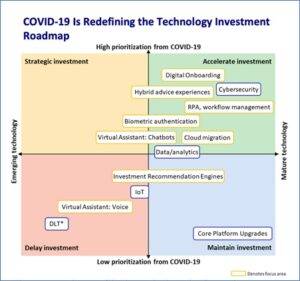By Awaad Aamir
COVID-19’s impact is omnipresent. The wealth management field hasn’t been spared from pandemic-driven changes. Through the haze of the initial response, the outlook for wealth management IT spending priorities is coming into focus.
While much uncertainty remains, it’s clear that the technology investment roadmap is shifting. The coming three years are likely to be a time when most wealth management firms move forward cautiously. Until the initial fallout from the pandemic eases around mid-2021, budgets will likely stay on hold. Decreases in revenue may impact IT spending that had been planned for 2020 and 2021, with non-essential projects being put on hold and resources shifting to support the digital capabilities focused on client engagement. The next phase, 2022–2023, will likely see IT spending growth.

One of the top areas of shifted focus for 2020–2021 is accelerated investment in high priority, mature technologies that were being already being considered before the pandemic. Cloud migration is among the most common areas of emerging technology investment, as revealed in Celent’s Wealth Management CIO Survey (March 2020). Other areas of focus include cybersecurity, digital onboarding, and biometric authentication. Looking slightly further out to 2022–2023, the focus on cloud migration is expected to deepen. Wealth management firms can embrace this trend by supporting implementation of a hybrid advice model which will position them to serve clients digitally—at a safe distance.
Innovative Uses of Cloud in Wealth Management
Innovative wealth managers are already using cloud to derive cutting edge insights and facilitate digital experiences. Firms are prioritizing proven technologies while also adjusting their business models to concentrate on survival. Cloud adoption supports strategic initiatives by improving technological capacity and time to market for new products and services, while reducing the number of legacy systems. Cloud adoption has also been proven to decrease spending on external hardware.
Some wealth management firms are accelerating toward a multi-cloud deployment architecture, in which a firm splits its deployments across multiple cloud locations, selecting best-in-class cloud services from public cloud providers (such as AWS, Azure, and Google Cloud) and private clouds. Larger wealth management firms are now migrating away from mainframe computing and toward a multi-cloud approach. This enables faster deployments, optimized scalability, and enhanced client experience. Current examples of multi-cloud in wealth management include Banco Sabadell hosting its infrastructure on IBM public cloud to modernize applications; UBS migrating its 25 data centers to Azure; and HSBC re-architecting its core platform with Google Cloud.
Cloud adoption also allows wealth management firms greater access to enhanced data analytics and artificial intelligence (AI) capabilities. Wealth managers are employing existing technology stacks within public clouds. These public cloud services are tools that enable frictionless deployment of AI and machine learning (ML) functionalities to the front office. Vanguard now utilizes AWS’s cloud integrated models that deliver bespoke, data-driven analytics and portfolio recommendations. RBC has unveiled a private AI cloud that brings transformative intelligent applications to market in record time. TD is relying on Azure for services that derive customer data analytics for 100 million daily records of data.
As the focus on cloud migration deepens, so will adoptions of SaaS and multi-cloud solutions. Wealth managers will shift to a remote advisory model. Doing so requires them to reprioritize their development roadmaps, and optimize their operating model in order to provide hyper-personalized offerings in an expanded product set. Multiple steps are required to achieve a frictionless advisor-client experience across a geographically dispersed environment. Cloud adoption is likely to be the highest priority mature technology driving these initiatives forward. Additionally, bandwidth from 5G have the potential enable remote collaboration/ work models as advisors shift towards a contact-center like model.
Next Steps
To prepare for the coming technology changes in wealth management, firms should embrace a holistic view of how cloud fits into its transformation plans:
- Don’t automate. Wealth management is a relationship-centric business. Interpersonal interaction is key. An advisor’s core value proposition is personalized advice and attentive service. Firms must view technology as an “enabling tool,” not a “replacement tool.” Stay focused on this as you migrate to and embrace cloud technologies.
- Recognize the need for speed. As wealth management firms move toward a hybrid advice model, as supported by cloud services, they must prepare to provide clients’ expectations to meet the standards established by big tech and fintech. Prioritize remote communication and frictionless onboarding.
- Lead from the back. Digitization of the back office is just as important as front office innovations. Seamless flow of data across the IT stack supports effective integration of the CRM and financial and portfolio management tools. Together these foster an expert, team-based servicing model that aligns with client needs.
- Resist the urge to save. COVID-19 may drive immediate cost-cutting measures, but focus on the long term. Support innovation by reallocating (rather than cutting) resources.
Awaad Aamir is a wealth management analyst at Celent, a global research and advisory firm focused on technology and business strategies in the financial services industry





















